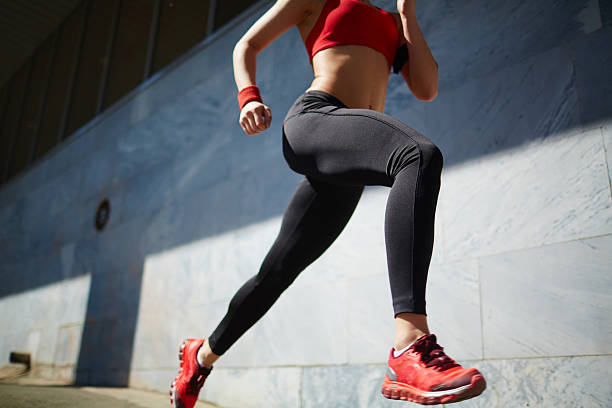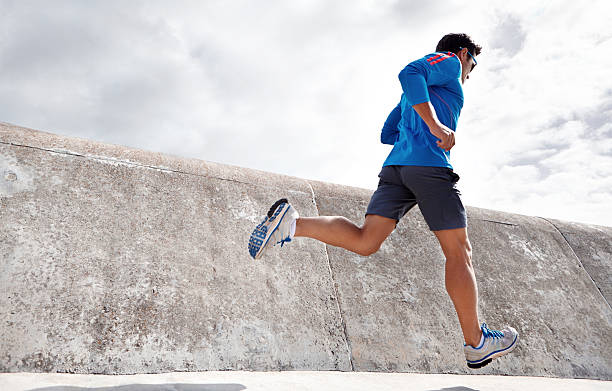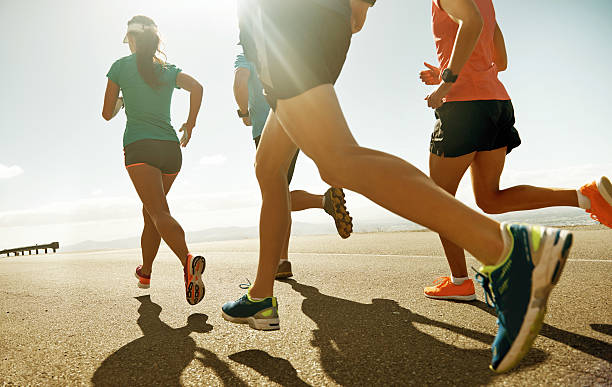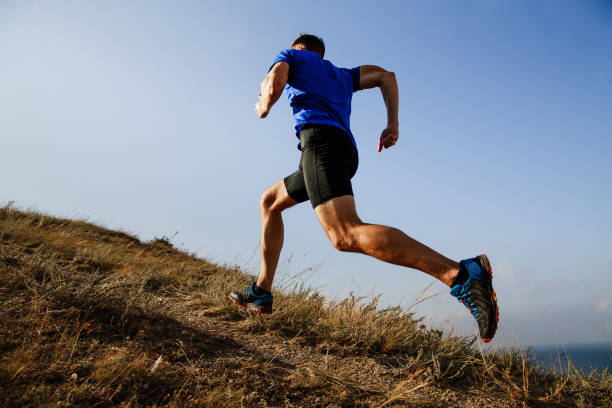Are your legs bigger after running? As different people will have different experiences when they run, there is no conclusive answer to this query. While some people may experience increased leg size as a result of running, others might not experience any change at all. Running frequency, run intensity, and genetics are just a few of the variables that can affect whether or not it increases the size of your legs.
Does Running Make Your Legs Bigger?
Everything depends on your eating habits, exercise routine, and other activities. Running typically results in slimmer rather than larger legs. This is what running does, it replaces fat with muscle.
Running is a cardio exercise that burns fat. By burning fat, you make room for your muscles. Although the fat you burned has increased the size of your legs, they will still get stronger and more muscular. Your legs will typically look slimmer after a run.
You can alternate between sprinting and brisk jogging by using interval training. An exercise method called interval training combines short bursts of high intensity with slower, more steady effort. Interval training burns more calories than continuous exercise, claims the British Journal of Sports Medicine. Additionally, interval training can increase your calorie burn for several hours following your workout.
If you run properly, you’ll see a difference in your calves. Running at a moderate intensity will accelerate the growth of your glutes, hamstrings, calves, and quads.
Additionally, yoga can improve your flexibility, muscle tone, and weight loss. Depending on the number of calories consumed, your legs might get slimmer. Running may cause you to lose body fat, resulting in slimmer thighs and legs. Your legs will most likely look more defined after running because it burns more calories than jogging.
Genetics
The shape and size of your legs will also depend on your genetic makeup.
You may therefore be predisposed to gaining muscle faster than others.
Running will only exacerbate the problem and might even make you too bulky.
In essence, no matter how hard they try, people with stocky builds are unlikely to transform into long-leg marathon runners.
You might want to think about switching from running to something else if risky genetics are a problem for you as well.
For instance, swimming is a great cardio exercise that is less leg-intensive than running.
Your genetic makeup plays a major role in determining your leg size and shape.
Running can help people add muscle more easily than other people do.
Types of Running
Long-Distance Running
There are two aspects to the reason why long-distance runners appear to be lean.
A competitor’s chances of winning are improved by several factors, including weight and the amount of mass carried by the thighs. So it’s not a good idea to get bigger.
Second, long-distance running itself has a detrimental impact on the process of muscle growth.
The culprit is the stress hormone cortisol, which rises during prolonged aerobic exercise and prevents muscle gain, which together with the calorie-burning intensity gives the appearance of being slender.
Long-distance running not only tones your thighs, calves, and glutes but also burns more calories.
Running for one hour at a pace of 6 mph will result in a calorie burn of almost 800.
Your legs will undoubtedly get slimmer as a result of losing calories, which also helps you lose excess weight.
Sprints
The majority of sprinters have thighs that are very muscular and clearly defined.
When competing, they must be able to literally explode, and that requires properly developed fast twitch muscles.
They add extra weight, like a weighted vest, or run up a hill to bulk up.
By doing this, they stimulate the growth of their calves, glutes, hamstrings, and quadriceps by increasing the tension in them.
They also use other exercises that promote muscle growth, like plyometrics and Olympic lifts.

Factors That Affect a Runner’s Leg Mass
Workout Intensity
Running is cardio, but how you do it can still affect how it affects you.
If you do it frequently, going for long runs at a leisurely pace is the best way to reduce the size of your thighs and calves.
Conversely, sprints tend to focus more on toning and slightly buffing up your legs.
Your body’s final appearance will also be influenced by the additional workouts you add to your training regimen.
Building muscle is accomplished through weightlifting, whereas fat is burned during any aerobic activity that raises your heart rate and promotes weight loss.
Diet
Your weight will be significantly impacted by the type and quantity of your primary nutrition source.
We advise speaking with your doctor about the best nutritional path for you since maintaining a complex balance is usually a challenge.
The irony is that proteins aid in your ability to gain muscle mass when you use the proper strength training techniques. Carbs, on the other hand, are a runner’s best friend. In either case, fat consumption should be reduced.
Nevertheless, there is a small catch.
Running increases appetite for some people even though it is a cardio activity that burns calories. Due to this, you may experience extreme hunger following a run.
Even worse, if your initial goal is to lose weight, carbohydrates can have a very counterproductive side effect that is almost addictive.
Here, having a powerful will is important. Your meal plans must be followed. You can eat after a run, but you should refrain from overindulging in fatty and processed foods.
Initial Body Shape
People frequently overlook the fact that genetics play a significant role in body shape, including how your metabolism works and where your body stores fat.
Your genetic makeup is thought to be responsible for between 70% and 80% of your propensity to gain weight.
However, that does not imply that exercise has no value.
Let’s use a sedentary lifestyle as an example. It’s detrimental to your health on a variety of levels, including cardiovascular function and mood regulation.
Run primarily for the purpose of improving your fitness.
The benefits to your physical and mental health should always come first, though you may come across some tips here and there that will slightly change how much muscle or fat you have.

How to Slim Down Your Legs by Running
Take Mileage over Pace Any Given Day
When people consider running to lose weight, they typically go faster than they should. Avoid sprinting, which is what that is.
This not only puts them at risk for harm, but it also doesn’t really accomplish their objective.
You must put more emphasis on mileage than speed if you want to burn fat with cardio over the long term. Running endurance is all about doing that.
So, focus on regular long runs and easy jogging sessions. Add a mile at a time after completing two miles at your fastest possible pace.
Lack of breath is not a requirement for endurance. You can reduce your heart rate without exceeding 70% of your peak performance.
Don’t just believe what we say.
Marathon runners do that, and observe how lean they typically are!
Keep Strength Workouts to a Minimum
Cutting out anaerobic exercise and concentrating on aerobic cardio are the best ways to prevent over-bulking out.
You don’t have to stop using it altogether. Even so, it’s crucial to occasionally work your muscles as a supplement to your endurance training.
For runners who only want to conserve energy and not build leg muscles, going to the gym for one leg session each week may be sufficient.
To increase the bulk mass, it won’t be easy enough to tone your legs for running.
Boost Your Training Plan
Even for devoted runners, going for daily long, easy runs can get boring and monotonous after a while.
Cross-training is the answer in this situation.
Cross-training in this context means adding a few days of different workouts to your running regimen.
Numerous other exercises can assist you in losing extra weight. Alternate between run days and other workouts, choosing your favorites.
Exercises that might be effective include walking, jogging, cycling, jumping jacks, and swimming. so long as you stay away from monotonous strength training.
Pick Balanced Diets for the Win
We cannot emphasize enough how crucial it is for athletes to consume a balanced diet. The predominant energy source in a runner’s diet is typically higher in carbohydrates.
You’ll also need to reduce the fat content, but you don’t want to stop eating protein altogether. You run the risk of losing muscle fiber if not.
Keep in mind that maintaining your current muscles without adding bulk to them is your goal here, not depleting them!
The American College of Sports Medicine suggests aiming for 0.35 grams per pound of body weight per day for this dietary objective.
You should keep in mind that calorie-deficit diets typically begin with a gap of no more than 500 calories. Therefore, the amount of calories you must burn to offset your intake is only 500.

How to Bulk Up Your Legs by Running
Sprint as Much as You Can
Increasing your pace can be exhausting, but it makes your running sessions more productive.
Keep your sprints brief and straightforward if you still lack the stamina to continue moving forward at a slower pace.
To switch between different intensity levels, you can also include sprinting laps in between easy runs and jogging laps.
Just be careful to warm up and cool down properly to prevent injuries!
Spice Up Your Runs
Your leg muscles can be worked out and you can develop bigger thighs and calves by incorporating strength training into your running sessions.
In an ideal world, you might add long jumps and hill sprints to your weekly workout schedule on two different days.
Finish your runs with pushups and planks for a quick workout before stretching out to cool down.
Rely on Proteins
While strength training can promote muscle growth, it is useless if your body cannot obtain the necessary building materials.
Avoid dipping below 0.8 grams of protein per pound of body weight if you regularly lift weights.
A lower intake may put you at risk for muscle depletion in addition to reducing your ability to gain mass.
Never Skip Leg Day
Participating in anaerobic strength training days is the most crucial aspect of developing leg muscles.
Just be careful not to schedule your leg exercises on days when you will be running long distances.
Additionally, you’ll need to perform a variety of exercises to work for every muscle group. You don’t want to develop an unbalanced bulk!
Close Note: It Depends
Next time you hear someone asking: “Are your legs bigger after running?” you can clear that misconception right up.
Running helps you burn fat and tone your legs without making them bigger, giving you the legs of famous marathon runners! However, there are far too many things to take into account, from how hard you run to what other exercises you do. Running leg muscles can be bulked up by adding strength training, eating enough protein, and taking lots of rest days to your training regimen.
Last but not least, you must remember that genetics and bone structure are very important factors in determining any given body shape.
